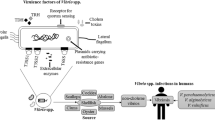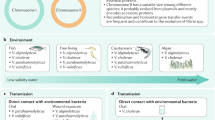Abstract
Vibrio vulnificus is an estuarine bacterium which occurs in high numbers in filter-feeding molluscan shellfish, such as oysters. In individuals with certain underlying diseases, ingestion of the bacterium, e.g., in raw or undercooked oysters, can lead to a rapid and extremely fatal infection. Indeed, this one bacterium is responsible for 95 % of all seafood-borne deaths. In addition, the bacterium is capable of entering a preexisting lesion or cut obtained during coastal recreational activities, resulting in potentially fatal wound infections. This brief review, which comprised a presentation made at the Gordon Research Conference on “Oceans and Human Health,” reflects over 35 years of research on this bacterium in the author’s laboratory. It describes some of the known virulence factors and why males account for ca 85 % of all V. vulnificus cases. It notes the two genotypes now known to exist and how this pathogen enters a dormant, “viable but nonculturable” state during the winter months. Finally, the review discusses how global warming may be causing worldwide increases in the frequency and geographical extent of Vibrio infections.







Similar content being viewed by others
References
Oliver JD (2006) Vibrio vulnificus. In: Thompson FL, Austin B, Swing J (eds) Biology of vibrios. Amer Soc Microbiol Press, Washington, DC, pp 349–366
Jones MK, Oliver JD (2009) Vibrio vulnificus: disease and pathogenesis. Infect Immun 77:1723–1733
Oliver JD (2006) Vibrio vulnificus. In: Belkin S, Colwell RR (eds) Oceans and health: pathogens in the marine environment. Springer Science, New York, pp 253–276
Klontz KC, Lieb S, Schreibe M, Janowski HT, Baldy LM, Gunn RA (1988) Syndromes of Vibrio vulnificus infections. Clinical and epidemiologic features in Florida cases, 1981–1987. Ann Intern Med 109:318–323
Posadas BC, Posadas RA (2011) Consumer preferences for postharvest-processed raw oyster products in coastal Mississippi. Miss Agric Forest Exper Sta Bull. July 2011,1192. http://msucares.com/pubs/bulletins/b1192.pdf
Centers for Disease Control and Prevention (1993) Vibrio vulnificus infections associated with raw oyster consumption—Florida, 1981–1992. Morbid Mortal Week Rep 42:405–407
Oliver JD (2005) Wound infections caused by Vibrio vulnificus and other marine bacteria. Epidemiol Infect 133:383–391
Baker-Austin C, Trinanes JA, Taylor NGH, Hartnell R, Siitonen A, Martinez-Urtaza J (2012) Emerging Vibrio risk at high latitudes in response to ocean warming. Nat Clim Change. doi:10.1038/nclimate1628
Toda, K (2012) Bacterial endotoxin. In: Todar’s online textbook of bacteriology. http://textbookofbacteriology.net/endotoxin.html
Bowdre JH, Poole MD, Oliver JD (1981) Edema and hemoconcentration in mice experimentally infected with Vibrio vulnificus. Infect Immun 32:1193–1199
Elmore SP, Watts JA, Simpson LM, Oliver JD (1992) Reversal of hypotension induced by Vibrio vulnificus lipopolysaccharide in the rat by inhibition of nitric oxide synthase. Micro Pathogen 13:391–397
Merkel SM, Alexander S, Oliver JD, Huet-Hudson YM (2001) Essential role for estrogen in protection against Vibrio vulnificus induced endotoxic shock. Infect Immun 69:6119–6122
Oliver JD, Kaper J (2007) Vibrio species. In: Doyle MP, Beuchat LR (eds) Food microbiology: fundamentals and frontiers, 3rd edn. Amer Soc Microbiol, Washington, DC, p. 343-379.
Centers for Disease Control and Prevention (2011) Vital signs: incidence and trends of infection with pathogens transmitted commonly through food—Foodborne Diseases Active Surveillance Network, 10 U.S. sites, 1996–2010. Morbid Mortal Week Rep 60:749–755
Centers for Disease Control and Prevention (2009) Vibrio vulnificus. http://www.cdc.gov/nczved/divisions/dfbmd/diseases/vibriov/technical.html
Food and Drug Administration (1999) Performance standard for Vibrio vulnificus; request for comments. Federal Register 64:3300–3301
Klontz KC (1997) Estimated number of persons at increased risk for Vibrio vulnificus septicemia. Memorandum to Philip Spiller, Director, Office of Seafood. http://www.cspinet.org/reports/vibrio_vulnificus/10.html#N_5_
Warner JM, Oliver JD (1998) Randomly amplified polymorphic DNA analysis of starved and viable but nonculturable Vibrio vulnificus cells. Appl Environ Microbiol 64:3025–3028
Cohen ALV, Oliver JD, DePaola A, Feil EJ, Boyd EF (2007) Emergence of a virulent clade of Vibrio vulnificus and correlation with the presence of a 33-kilobase genomic island. Appl Environ Microbiol 73:5553–5565
Rosche TM, Yano Y, Oliver JD (2005) A rapid and simple PCR analysis indicates there are two subgroups of Vibrio vulnificus which correlate with clinical or environmental isolation. Microbiol Immunol 49:381–389
Morrison SS, Cain A, Froelich B, Williams T, Taylor C, Baker-Austin C, Verner-Jeffreys D, Hartnell R, Oliver DJ, Gibas CJ (2012) Pyrosequencing-based comparative genome analysis of Vibrio vulnificus environmental isolates. PLoS ONE 7:e37553. doi:10.1371/journal.pone.0037553
Ferenci T (2005) Maintaining a healthy SPANC balance through regulatory and mutational adaptation. Mol Microbiol 57:1–8
King T, Ishihama A, Kori A, Frenci T (2004) A regulatory trade-off as a source of strain variation in the species Escherichia coli. J Bacteriol 186:5614–5620
Rosche TM, Binder EA, Oliver JD (2010) Vibrio vulnificus genome suggests two distinct ecotypes. Environ Microbiol Rep 2:128–132
Warner EB, Oliver JD (2008) Multiplex PCR assay for detection and simultaneous differentiation of genotypes of Vibrio vulnificus biotype 1. Foodborne Path Dis 5:691–693
Warner EB, Oliver JD (2008) Population structure of two genotypes of Vibrio vulnificus in oysters (Crassostrea virginica) and sea water. Appl Environ Microbiol 74:80–85
Birkenhauer JB, Oliver JD (2003) Use of diacetyl to reduce the load of Vibrio vulnificus in the Eastern oyster, Crassostrea virginica. Food Protect 66:38–43
Oliver JD (2000) Public health significance of viable but nonculturable bacteria. In: Colwell RR, Grimes DJ (eds) Non-culturable microorganisms in the environment. Amer Soc Microbiol Press, Washington, DC, pp 277–300
Oliver JD, Hite F, McDougald D, Andon NL, Simpson LM (1995) Entry into, and resuscitation from, the viable but nonculturable state by Vibrio vulnificus in an estuarine environment. Appl Environ Microbiol 61:2624–2630
Smith BE, Oliver JD (2006) In situ and in vitro gene expression by Vibrio vulnificus during entry into, persistence within, and resuscitation from the viable but nonculturable state. Appl Environ Microbiol 72:1445–1451
Kong I-S, Bates TC, Hülsmann A, Hassan H, Oliver JD (2004) Role of catalase and oxyR in the viable but nonculturable state of Vibrio vulnificus. FEMS Microbiol Ecol 50:133–142
Høi L, Larsen JL, Dalsgaard I, Dalsgaard A (1998) Occurrence of Vibrio vulnificus biotypes in Danish marine environments. Appl Environ Microbiol 64:7–13
Paz S, Bisharat N, Paz E, Kidar O, Cohen D (2007) Climate change and the emergence of Vibrio vulnificus disease in Israel. Environ Res 103:390–396
Calewaert J–B, Desender M, Eparkhina D, McDonough N (2011) Climate change and marine ecosystem research results. Inventory report of relevant research and their outputs. http://www.clamer.eu/images/stories/deliverables/clamer_d1_1_inventrep_final.pdf
Centers for Disease Control and Prevention (2011b) Incidence of foodborne illness, 2010. http://www.cdc.gov/Features/dsFoodborneIllness/index.html
Newton A, Kendall M, Vugia DJ, Henao OL, Mahon BE (2012) Increased rates of vibriosis in the United States, 1996–2010: review of surveillance data from 2 systems. Clin Infect Dis 54(Suppl 5):S391–S395
Baker-Austin C, Newton A, Taylor N, Martinez-Urtaza J, Griffin R, Oliver JD (2012) Vibrio vulnificus disease burden in the USA, 1988–2010. Lancet (in press).
Boyd EF, Cohen ALV, Naughton LM, Ussery DW, Binnewies TT, Stine OC, Parent MA (2008) Molecular analysis of the emergence of pandemic Vibrio parahaemolyticus. BMC Microbiol 8:110–123
Daniels NA, Ray B, Easton A, Marano N, Kahn E, McShan AL, Del Rosario L, Baldwin T, Kingsley MA, Puhr ND, Wells JG, Angulo FJ (2000) Emergence of a new Vibrio parahaemolyticus serotype in raw oysters. A prevention quandary. J Amer Med Assoc 284:1541–1545
Kwak JS, Jeong H-G, Satchell JF (2011) Vibrio vulnificus rtxA1 gene recombination generates toxin variants with altered potency during intestinal infection. Proc Nat Acad Sci (USA) 108:1645–1650
Nair GB, Ramamurthy T, Bhattacharya SK, Dutta B, Takeda Y, Sack DA (2007) Global dissemination of Vibrio parahaemolyticus serotype O3:K6 and its serovariants. Clin Microbiol Rev 20:39–48
Thomas R (2011) Flesh-eating bacteria: coastal scourge (Vibrio vulnificus) is lurking in the estuaries. Nature Notes, Loyola University New Orleans http://loyno.edu/lucec/natural-history-writings/flesh-eating-bacteria-coastal-scourge-vibrio-vulnificus-lurking-estuaries
Pfeffer CS, Hite MF, Oliver JD (2003) Ecology of Vibrio vulnificus in estuarine waters of eastern North Carolina. Appl Environ Microbiol 69:3526–3531
Author information
Authors and Affiliations
Corresponding author
Rights and permissions
About this article
Cite this article
Oliver, J.D. Vibrio vulnificus: Death on the Half Shell. A Personal Journey with the Pathogen and its Ecology. Microb Ecol 65, 793–799 (2013). https://doi.org/10.1007/s00248-012-0140-9
Received:
Accepted:
Published:
Issue Date:
DOI: https://doi.org/10.1007/s00248-012-0140-9




